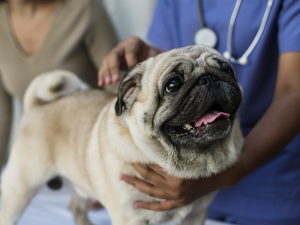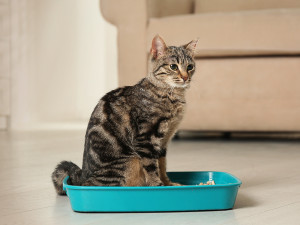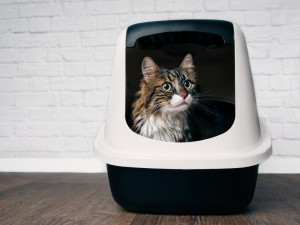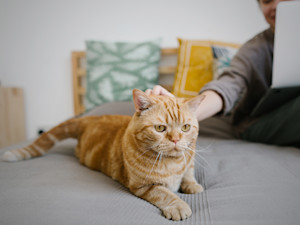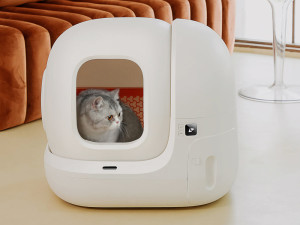It’s All a Little Poopy: Toxoplasmosis in Cats
Scoop cat poop early and often—and keep it away from your garden.
If you’re the kind of person who Googles, “My cat is sick; can I catch it?” every single time your cat looks even a little puke-y, you’re going to want to read ahead. There are a handful of diseases that you can catch from a cat, usually from infected feces, infected skin, or bites and scratches. One of the most commonly discussed is toxoplasmosis, one of the poop-related diseases.
This disease was once considered so worrisome that physicians would recommend that pregnant people rehomeopens in new tab their cats. The Centers for Disease Control (CDC) now statesopens in new tab that you can keep your cat and just take general precautions instead. Let’s review what toxoplasmosis is, how cats get it, how people get it, and how to avoid getting it without getting rid of your cat.
Check out customizable policies from our friends at Lemonade Pet Insurance—so you only pay for what you need.
What is toxoplasmosis and how do cats get it?
Toxoplasmosis is an infection caused by microscopic protozoa — single-celled organisms — called Toxoplasma gondii. Toxoplasmosis can affect mammals, including humans, and is of particular concern in households with cats.
Cats are the definitive hosts for Toxoplasma gondii, meaning they are the only species in which the parasite can sexually reproduce. Cats become infected by ingesting birds, small mammals, or raw/undercooked meat infected with tissue cysts. The parasite completes part of the reproductive process within the cat, then the cat sheds oocysts (thick-walled cells that contain fertilized eggs) in their feces. These oocysts contaminate the environment where the cat poops — soil, water, or litter box — and become infective after one to five days.
How much do you spend on your pet per year?
Animals in the environment, often birds, small mammals, or livestock, become infected by ingesting the oocysts from contaminated soil or water. The oocysts will burst open within these animals and form cysts in their muscle tissue, restarting the cycle.
What are the symptoms of toxoplasmosis in cats?
Healthy adult cats may have a short bout of diarrhea at worst, but most cats infected with Toxoplasma gondii don’t show any symptoms. Young kittens and cats with compromised immune systems have a greater risk of developing clinical signs associated with the parasite dividing and migrating through the body.
Young kittens with toxoplasmosis will display a general failure to thrive known as “fading kitten syndrome.” These kittens are often born underweight and have difficulty feeding and maintaining normal body temperatures. Without (and sometimes despite) significant nursing care, they often don’t survive. Toxoplasmosis symptoms seen in cats of all ages can include:
Lethargy
Fever
Vomiting and Diarrhea
Anorexia
Jaundice (yellowing of the skin or eyes)
Uveitis (inflammation within the eye)
Blindness
Neurological signs (including seizures, trouble walking, behavior changes, paralysis)
Pneumonia
Miscarriage or stillbirth in pregnant cats
How do you diagnose toxoplasmosis in cats?
Because most cats do not show any symptoms of infection, many Toxoplasma infections go undetected. Even when infection is suspected, confirmation can be difficult. Usually, a combination of medical history, clinical signs, blood work, and response to treatment are used to make a diagnosis. Antibody levels may be measured to determine likelihood of current disease, previous exposure, or risk of future exposure.
How do you treat toxoplasmosis in cats?
Antibiotics are the primary treatment for toxoplasmosis in cats. In addition to antibiotics, your vet may recommend secondary treatments to address inflammation in the eyes or central nervous system. Depending on the severity of disease, supportive care may be required to address dehydration, anorexia, nausea, or discomfort.
With appropriate treatment, most cats show noticeable improvement within 72 hours. Prognosis is worse in young kittens, immunocompromised cats, and cats that develop neurologic symptoms. Even if a cat’s symptoms resolve, medication cannot fully eliminate the organism from the tissues. This means that recurrence is possible, though rare.
The solution: Scoop the poop early and often.
All humans are at risk for being infected by Toxoplasma gondii. Similar to cats, people with healthy immune systems typically don’t have any symptoms. Humans can get infected through contact with infected cat feces, by ingesting undercooked and infected meat, by drinking infected water, in utero, and (very rarely) through transfusions and transplants.
Let’s focus on the cat crap for a minute. Because cats infected with Toxoplasma gondii will shed oocytes in their feces, anyone who handles cat feces is at risk for exposure. The most obvious point of contact is the litter box. A less commonly considered exposure is gardening or consuming home-grown produce if neighborhood cats use the garden as a litter box. Outdoor cats may also use playground sandboxes as giant litter boxes, creating a point of exposure for children.
Becoming infected with Toxoplasma gondii during pregnancy carries the risk of passing the parasite on to the fetus, which can result in a condition called congenital toxoplasmosis. Congenital toxoplasmosis can result in blindness, neurological disease, mental disorders, or stillbirth. People infected with Toxoplasma while pregnant may experience flu-like symptoms or no symptoms at all.
People can also take multiple precautions to avoid getting Toxoplasma from cats, especially those who are pregnant or immune-compromised. People who enjoy gardening and garden-fresh produce should wear gloves while gardening and wash their hands afterward. The produce should also be carefully washed. Because it takes at least 24 hours for the oocysts in cat feces to become infective, litter boxes should be cleaned daily to minimize risk. If possible, those who are pregnant or immune-compromised should avoid litter box duties completely.
You can protect your cat from Toxoplasma by feeding a cooked, commercial diet. Keeping your cat indoors prevents them from hunting small prey animals like birds and rodents that may have infected tissue cysts.




